Large-fruited honeysuckle variety “Pride of Bakchar”
Bakchar's pride is a young honeysuckle variety that has become a favorite among gardeners due to its many positive characteristics. Among other things, the plant’s resistance to diseases, pests and frosts, high yield and large-fruitedness are particularly noteworthy. In this article we will tell you in detail how to properly plant this honeysuckle and care for it in order to get a rich harvest of berries.
Description of the honeysuckle variety Pride of Bakchara
This is a variety of edible honeysuckle, bred by domestic breeders. 100 g of fruit contains 6.4% sugar, 2.6% acids and 35.1 mg of vitamin C.
The berries have anti-inflammatory, disinfectant, urinary and choleretic properties, reduce blood pressure, strengthen capillaries and increase the overall tone of the body.
Origin and development
Honeysuckle The pride of Bakchar was bred by employees of the Federal State Unitary Enterprise “Bakcharskoye” (Tomsk region) I. K. Gidyuk, A. P. Pavlovskaya, N. V. Savinkova and A. T. Tkacheva as a result of free pollination of Turchaninov’s honeysuckle.
The variety was included in the State Register of Russia in 2006.
Characteristics, description of appearance, taste
This medium height (1.5-1.6 m in height and up to 1.2 m in width) a bush with a stack-shaped crown, long curved light brown shoots and brown arched skeletal branches. The leaves are medium matte leathery and slightly pubescent, colored dark green. The flowers are yellowish-green, bell-shaped.
The berries are curved-spindle-shaped, weigh on average 1.3–1.7 g, reach a length of 4.5 cm, and are covered with rough purple skin with a silver-white coating. The pulp is fibrous, dense, medium juicy, odorless, with a balanced sweet and sour taste, in which bitterness appears if the variety is grown improperly.
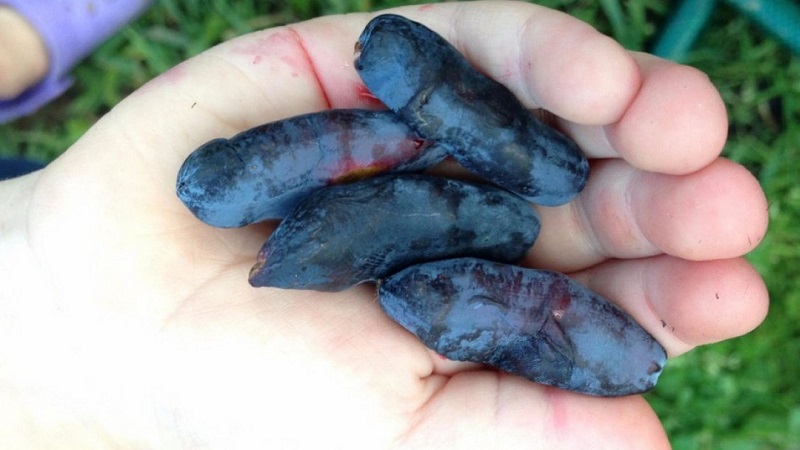
Features of application
Bakchar's Pride Berries consumed fresh, frozen, used for making preserves, jams, compotes, tinctures, decoctions and wine.
Due to the chaotic arrangement of branches, some of which grow vertically, and some are directed downwards, the bushes of Bakchar's Pride do not have a decorative appearance and are not used to decorate the site.
Ripening period, yield and fruiting
This is an early ripening variety of honeysuckle - the harvest is ready for harvesting after July 20th. Pride of Bakchar begins to bear fruit 5 years after planting, reaching maximum productivity by 8–10 years. An average of 2.5–4 kg of berries are harvested from bushes of this age.
Resistance to diseases and pests
Bakchar's pride is resistant to diseases and pests, but in the absence of preventive measures or improper care, it can be affected by fungal diseases (rot, spotting, powdery mildew), scale insects, caterpillars, aphids, and mites.
Resistance to cold and drought
The variety does not tolerate drought well - lack of moisture leads to bitterness in the berries. At the same time, swampy soil provokes the development of fungal diseases.
The bushes have good frost resistance and can withstand air temperatures down to -8°C during return frosts.
Suitable regions and climate requirements
The variety is included in the State Register of Russia with permission for cultivation in the Northern, Northwestern, Central, Far Eastern, Volga-Vyatka, Central Black Earth, North Caucasus, Middle Volga, Lower Volga, Ural, Western and Eastern Siberian regions.
Advantages and disadvantages of the variety
Among the main advantages of the variety are:
- resistance to adverse weather conditions, diseases and pests;
- ability to withstand return frosts down to -8°C;
- large fruit;
- delicate, balanced taste of berries;
- good transportability and keeping quality;
- unpretentiousness;
- high productivity.
The disadvantages include:
- berry shedding;
- lack of decorativeness;
- need for pollinating varieties.
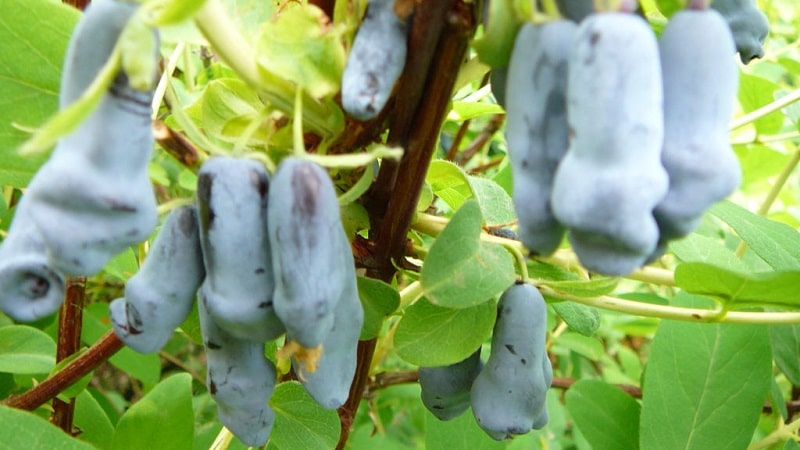
Difference from other varieties and hybrids
Comparison of Pride Bakchar with other early and mid-ripening varieties of honeysuckle:
| Variety | Average weight of berries, g | Taste | Berry color | Productivity, kg/bush |
| Pride of Bakchar | 1,3–1,7 | Sweet and sour | Violet | 2,5–4 |
| Violet | 1,14–1,5 | Blue-violet | 1,8 | |
| Vasyuganskaya | 0,8 | Dark purple | 1,5–2,5 | |
| Berel | 0,4–1 | Sourish-sweet with tartness | Dark blue | 3-4 |
Agricultural technology
Bakchar's pride is the unpretentious honeysuckle. However, to obtain a high-quality harvest, it is important to meet a number of conditions and fulfill the basic agrotechnical requirements of the crop: choose the right planting site and provide the plants with proper care.
Choosing a place in the garden and preparing holes
For planting this variety choose a well-lit and ventilated place, but protected from drafts and gusty winds.
Reference. The permissible level of groundwater is at least 1 m.
Lack of light and moisture leads to a decrease in yield and the appearance of bitterness in the taste of fruits.
Preparing for landing
When purchasing seedlings, preference is given to one- or two-year-old specimens without signs of disease or pest damage. The root system can be open or closed.
The area is first cleared of plant residues and debris, dug up, and fed with organic fertilizers (10 kg of manure or humus). Add 40 g of superphosphate and 30 g of potassium salt for every 1 m² of area.
Soil requirements
The soil must be light, loose, fertile, have good aeration, moisture permeability and a neutral acidity level.
Dates, scheme and rules of planting
The optimal time for planting seedlings with an open root system is autumn (end of August - end of October), with closed - spring, before the buds open.
Landing algorithm:
- In the prepared area, dig planting holes 40 cm deep and 50 cm in diameter.
- Place a drainage layer of broken bricks or stones at the bottom of each hole, pour a nutritious soil mixture (10 kg of compost, 1 kg of wood ash and 25 g of superphosphate) on top and pour in 10 liters of warm water.
- Form a hill from moist soil, place a seedling on it, spreading the roots along the slopes.
- Sprinkle the plant with loose soil so that the root collar is buried a maximum of 2 cm.
- Compact the soil, water the plantings abundantly, and mulch the tree trunk circle.
The optimal distance between bushes is from 1.5 m.
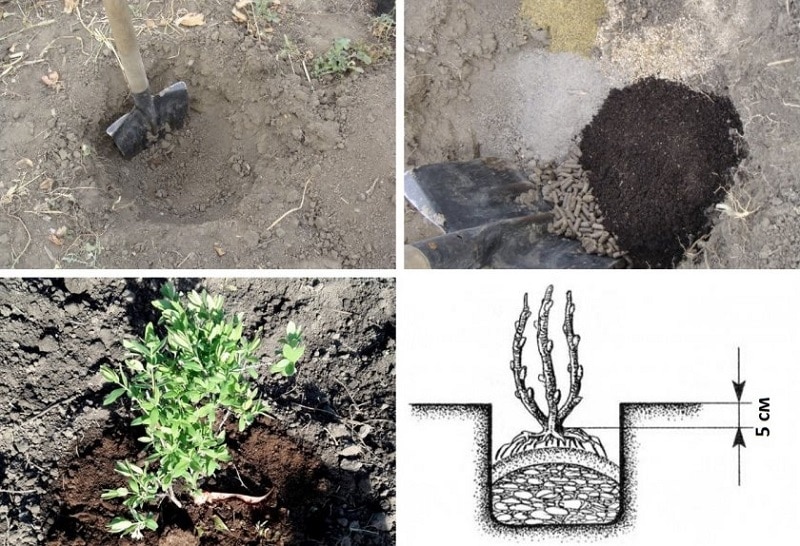
Features of cultivation
The frequency of watering is determined based on the condition of the soil: it should not dry out or be waterlogged. During flowering and fruiting, as well as during dry periods, honeysuckle is moistened daily, spending 30 liters of water per bush.
After each watering, the soil is loosened to avoid the formation of a dry crust on its surface and to improve the access of oxygen and moisture to the roots. At the same time, they get rid of weeds.
Reference. At the beginning of spring, the bushes are watered with hot (+60°C) water to awaken the buds and get rid of pests and fungal spores.
Plants begin to be fed 2 years after planting. Then in the spring, before the buds awaken, organic fertilizers (humus, compost) are applied under the bushes, and in the fall, after harvesting, 0.5 liters of wood ash and 2 tbsp. l. superphosphate.
During flowering, complex mineral fertilizers containing potassium, nitrogen and phosphorus are used, dry or dissolved in water. It is acceptable to spray the bushes with a urea solution (1 tbsp per 10 liters of water).
Every year in the spring they carry out sanitary pruning, getting rid of all dry, damaged, weak and elongated shoots. Bushes aged 6 years and older are regularly rejuvenated. To do this, all old branches are cut off at the root, the bush is formed from 5 strong shoots.
Pollinators
The pride of Bakchar is self-sterile honeysuckle; it requires cross-pollination to set fruit. The best pollinating varieties:
- Silginka;
- Blue spindle;
- Strezhevchanka;
- Blue bird;
- The Giant's Daughter;
- Delight;
- Bakchar giant.
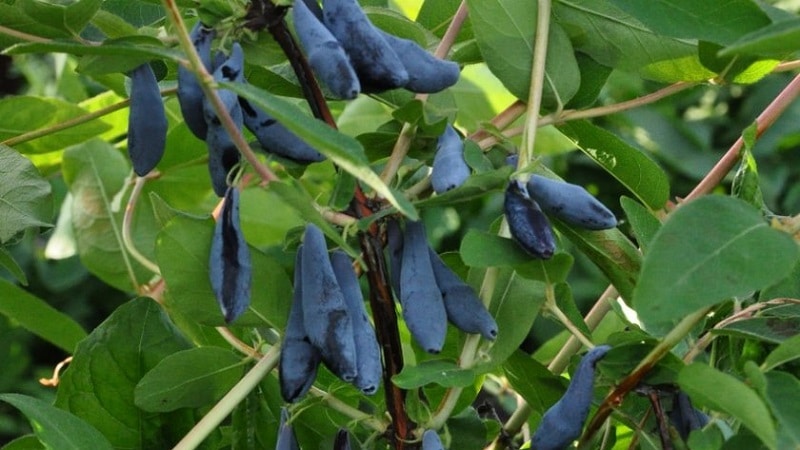
Disease and pest control
Diseases and pests that can affect Pride of Bakchar:
| Disease/pest | Signs | Treatment/prevention |
| Shchitovka | The pest feeds on the sap of the plant, the bushes dry out and die. | Spraying with Rogor twice, with an interval of 10 days. |
| Caterpillars | The appearance of holes on the leaves. | If the number of caterpillars is small, they are collected manually, otherwise the bushes are sprayed with Inta-Vira solution. |
| Aphid | The leaves turn yellow and curl. | The bushes are treated with the preparations “Confidor” or “Rogor”. |
| Ticks | The leaves curl, turn brown, and small holes appear in them. | For processing bushes, use “Mavrik” or “Tedion”. |
| Rot | The plant develops poorly and rot appears on it. | To prevent the disease, at the beginning of spring, plants are sprayed with a special solution (10 g of copper sulfate and 1 tablespoon of laundry soap per 10 liters of water) or “Fundazol”. For treatment, use wood ash, colloidal sulfur or the fungicidal drug “Topaz”. |
| spotting | Brown or brown spots appear on the leaves. | |
| Powdery mildew | The lower part of the leaf blades is covered with a white powdery coating. |
Preparing for winter
Due to the high degree of frost resistance, adult plants do not require additional winter shelter. Only young and immature seedlings are protected from frost with agrofibre.
Preparation for winter consists only of abundant (at least 40 liters of water per bush) moisture-replenishing watering and mulching of the tree trunk circle.
Reproduction
Honeysuckle can be propagated by seeds, but this is a labor-intensive process, so most often gardeners choose vegetative methods:
- Dividing the bush. In the spring, before the buds open, or in the fall, after shedding the leaves, a strong and healthy plant at the age of 3-4 years is dug up and divided into parts so that each has a full-fledged root. The delenki are planted in a permanent place. After a year they become plants.
- By layering. In June, several young vines are selected from an adult bush, bent to previously loosened soil, buried 4 cm and secured with special staples or wire. To speed up the appearance of roots, the bark is cut with a sharp, disinfected knife.In the spring, the rooted lashes are separated from the mother plant and planted in a permanent place. After 3 years they become full-fledged bushes.
- Green cuttings. After flowering, the young shoot is cut into pieces 10 cm long, the lower part of the resulting cuttings is freed from leaves and dipped in a solution of a growth stimulator (Kornevina, Epina) for 24 hours. A day later, the cuttings are planted in moist soil and covered with a jar or polyethylene to create a greenhouse effect.
Lignified cuttings are harvested in the fall, wrapped in cloth and stored during the winter in a container filled with sand or sawdust. In the spring they are planted in the ground at an angle of 45°, leaving 2 buds above the surface.
Difficulties in growing
When growing Bakchar's Pride, you may encounter the following problems:
- a decrease in yield or the appearance of bitterness in the taste of berries - the bushes grow in the shade;
- leaf plates are deformed, holes are noticeable on them - a sign of an attack by pests, for example, mites, aphids or caterpillars;
- a white coating on the bottom of the leaves is a symptom of powdery mildew, which most often occurs as a result of waterlogging of the soil.
Harvesting
Bakchar's Pride berries ripen in mid to late June. Their tendency to shed makes harvesting simple: spread some material under the bushes and shake the branches.
Fresh fruits are stored in the refrigerator for a week.
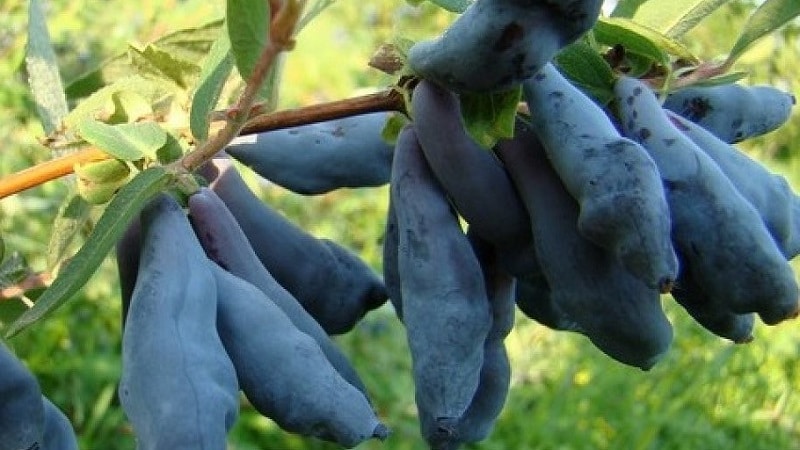
Tips and reviews from experienced gardeners
Gardeners recommend:
- plant at least 4 different varieties of honeysuckle on the site, maintaining a distance of 4 m between the bushes;
- If the site has acidic soil, add lime or dolomite flour to it before planting honeysuckle.
Reviews about the Pride of Bakchar variety are positive.
Valeria, Ivanovo: “When we harvested the first harvest of this honeysuckle, we were disappointed: the berries were very bitter. Friends said that the problem might be a lack of light, and it turned out to be so. On our site, next to the honeysuckle, there was a large tree that shaded the bushes. We got rid of it, and the next year we enjoyed delicious honeysuckle, which did not have a hint of bitterness. The berries, by the way, are very large and easy to pick. So we are very pleased with the variety".
Dmitry, Chita: “Excellent variety, I didn’t regret choosing it. Already 3 years after planting, they harvested a good harvest - a little more than 1.5 kg of berries, and a year later there were already almost 4 kg of fruit. The berries are large and tasty, the bush is unpretentious".
Conclusion
The pride of Bakchar is edible honeysuckle, which is characterized by a high degree of frost resistance, large fruit, good immunity and excellent yield. Among the disadvantages of the variety are self-sterility and a tendency to shed ripe berries.